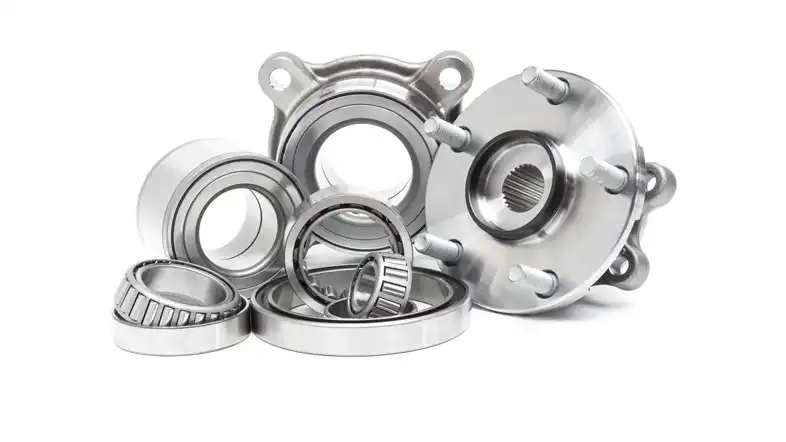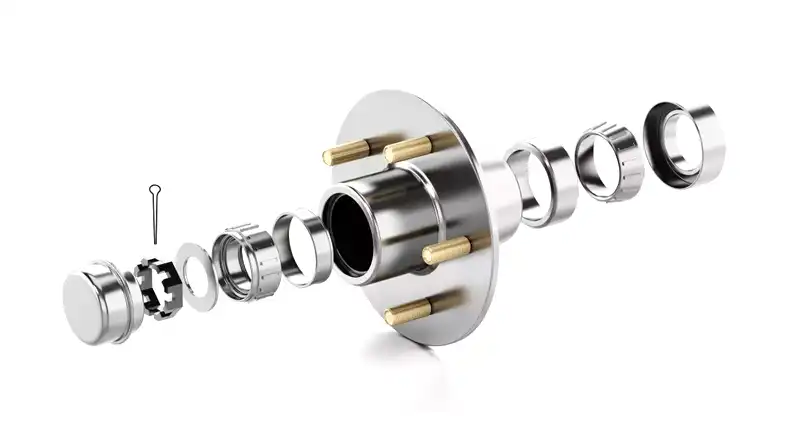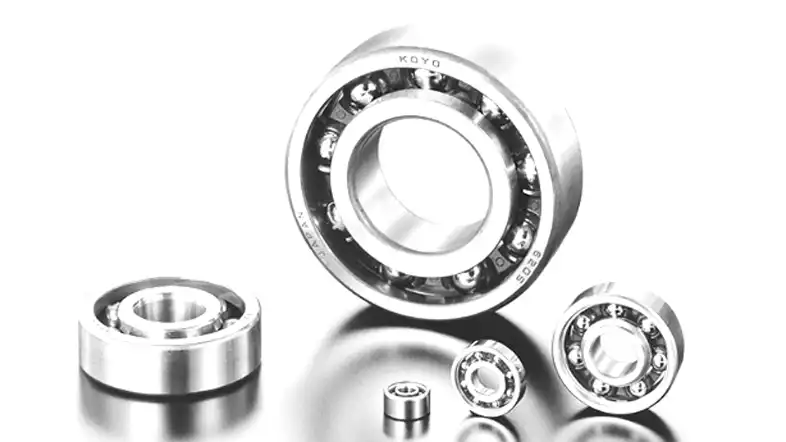A wheel bearing is a crucial component in the automotive world, often overlooked but essential for a smooth and safe ride. These small, inconspicuous parts play a significant role in the functionality of your vehicle’s wheels, ensuring they rotate with minimal friction.
Let’s delve into the intricacies of wheel bearings and why they merit your attention.
What Are Wheel Bearings?

The wheel bearing assembly typically consists of an inner and outer bearing, a set of steel balls or rollers, a cage to keep the balls or rollers separated, and an outer race or cup. The inner bearing is mounted on the wheel hub, while the outer bearing is usually part of the wheel hub assembly. The steel balls or rollers facilitate the rotation of the hub and, consequently, the wheel.
Wheel bearings can wear out due to factors such as normal wear and tear, exposure to harsh conditions, or lack of proper lubrication. When wheel bearings start to fail, common symptoms include noise (such as grinding or humming) coming from the wheel area, uneven tire wear, and excessive play or looseness in the wheel.
Regular maintenance, including proper lubrication and timely replacement when necessary, is essential to ensure the longevity and optimal performance of wheel bearings, promoting overall vehicle safety and efficiency. If you suspect an issue with your wheel bearings, it’s advisable to have them inspected and replaced by a qualified mechanic.
Structure of a Wheel Bearing

Let’s delve deeper into the structure of a wheel bearing to gain a better understanding of its components and functions.
Components of a Wheel Bearing
- Inner Ring: The inner ring is a crucial part of the wheel bearing, attaching to the vehicle’s axle. Its primary function is to provide structural support and ensure a stable connection to the rotating parts.
- Outer Ring: This component connects to the wheel hub and is responsible for maintaining the bearing’s overall stability. The outer ring plays a key role in supporting the entire structure during the rotation of the wheel.
- Rolling Elements: Wheel bearings can contain either balls or rollers as the rolling elements. These elements reduce friction between the inner and outer rings, allowing for smooth rotation. The choice between balls and rollers depends on the design and intended application of the wheel bearing.
- Cage: The cage, often made of steel, holds the rolling elements in place within the wheel bearing. Its primary function is to maintain the proper spacing between the rolling elements, ensuring they move freely without excessive friction.
Function of Each Component
- Inner and Outer Rings: The inner and outer rings work in tandem to support the entire load of the vehicle. The inner ring attaches to the stationary part of the vehicle, while the outer ring connects to the rotating wheel. Together, they create a stable platform for the wheel to spin.
- Rolling Elements: The balls or rollers between the inner and outer rings reduce friction during rotation. This minimizes wear and tear on the bearing, allowing for extended longevity and optimal performance of the wheel.
- Cage: The cage has a critical role in maintaining the proper alignment of the rolling elements. It prevents them from coming into contact with each other, ensuring they distribute the load evenly and operate smoothly.
Importance of Lubrication
Proper lubrication is essential for the efficient functioning of a wheel bearing. It helps reduce friction between the moving parts, preventing premature wear and ensuring the bearing operates quietly and smoothly. Over time, however, the grease or lubricant can break down, leading to increased friction and potential damage to the bearing.
Regular maintenance, including checking and replenishing lubrication, is crucial to the overall health of the wheel bearing. Adequate lubrication not only prolongs the lifespan of the bearing but also contributes to the safety and performance of the vehicle.
Understanding the intricate structure of a wheel bearing allows vehicle owners to appreciate its significance in ensuring a safe and smooth driving experience. Regular inspections and timely maintenance can help identify and address potential issues before they escalate, ultimately contributing to the longevity of the entire wheel assembly.
What Does a Wheel Bearing Do

What do wheel bearings do?
A wheel bearing serves a critical role in a vehicle’s wheel assembly by facilitating smooth and efficient wheel rotation.
Here are the key functions of a wheel bearing:
Supporting Vehicle Weight: The primary function of a wheel bearing is to support the weight of the vehicle. It is located between the wheel and the axle, carrying the load of the vehicle while allowing the wheel to rotate freely.
Reducing Friction: Wheel bearings are designed to minimize friction between the wheel and the axle, which is crucial for efficient wheel rotation. The reduction of friction helps in achieving better fuel efficiency and overall performance.
Enabling Smooth Rotation: The wheel bearing allows the wheel to rotate smoothly, both when the vehicle is in motion and when it is stationary. This smooth rotation contributes to a comfortable and stable ride for the occupants.
Maintaining Wheel Alignment: Wheel bearings play a role in maintaining proper wheel alignment. They help ensure that the wheels are correctly positioned and aligned with the vehicle frame, preventing uneven tire wear and improving handling.
Absorbing Axial and Radial Loads: Wheel bearings are designed to handle both axial (side-to-side) and radial (up-and-down) loads. This capability is crucial for supporting the vehicle’s weight and managing the forces generated during turns and maneuvers.
Sealing Out Contaminants: Many wheel bearings are equipped with seals to protect the internal components from contaminants such as dirt, water, and debris. This helps extend the lifespan of the bearing by preventing premature wear and damage.
Facilitating Steering: In some vehicles, the wheel bearing is integrated into the hub assembly, which is connected to the steering system. This integration allows the wheel bearing to contribute to the vehicle’s steering responsiveness.
The wheel bearings are essential components that contribute to the safe and efficient operation of a vehicle. Regular maintenance and prompt replacement when necessary are crucial to ensuring optimal performance and preventing issues such as noise, vibration, and compromised safety.
Signs of a Failing Wheel Bearing
Recognizing the signs of a failing wheel bearing is crucial for maintaining the safety and performance of your vehicle. Here’s a detailed explanation of the common indicators that suggest a wheel bearing may be in trouble:
Strange Noises
One of the most noticeable signs of a failing wheel bearing is the presence of unusual noises. These sounds often include:
- Grinding: A grinding noise, especially when turning, is a common indication of a deteriorating wheel bearing. This noise is typically caused by worn-out rolling elements within the bearing.
- Humming or Growling: A constant humming or growling noise that correlates with the vehicle’s speed can be a sign of a problematic wheel bearing. This noise tends to become more pronounced as you accelerate.
- Clicking or Snapping: Clicking or snapping sounds, particularly during sharp turns, may indicate a damaged wheel bearing. This can be a result of the uneven distribution of weight on the bearing.
Uneven Tire Wear
Inspecting your vehicle’s tires can provide valuable clues about the condition of the wheel bearings. Look for:
- Cupping or Scalloping: Uneven tire wear characterized by cupping or scalloping patterns is often associated with failing wheel bearings. The inconsistent rotation caused by a damaged bearing can lead to these abnormal wear patterns.
- Excessive Wear on One Side: If one side of the tires shows more wear than the other, it may signal a problem with the corresponding wheel bearing. Regularly monitoring tire wear can help catch issues early.
Steering Wheel Vibrations
Vibrations felt through the steering wheel can be an indicator of various issues, including a failing wheel bearing. Pay attention to:
- Vibrations at Certain Speeds: Vibrations that occur at specific speeds, especially on highways or during consistent driving, may point to an imbalanced or damaged wheel bearing.
- Changes in Steering Responsiveness: A compromised wheel bearing can affect the vehicle’s handling. If you notice changes in steering responsiveness or difficulty maintaining a straight path, it’s advisable to inspect the wheel bearings.
Addressing Signs Promptly
Recognizing these signs promptly is crucial for several reasons:
- Safety: A failing wheel bearing can compromise the vehicle’s stability and control, leading to safety hazards. Addressing the issue promptly ensures a safer driving experience.
- Preventing Further Damage: Ignoring signs of a failing wheel bearing can result in more extensive damage to the bearing and other components. Timely intervention can prevent costly repairs.
- Cost-Efficiency: Addressing wheel bearing issues early can often be more cost-effective. Neglecting the problem may lead to additional damage, necessitating more extensive repairs.
Regular visual inspections, listening for unusual sounds while driving, and being attentive to changes in vehicle performance are essential practices for identifying and addressing wheel bearing issues before they escalate. Remember, proactive maintenance is key to ensuring the longevity and reliability of your vehicle.
Causes of Wheel Bearing Failure
Lack of Lubrication
Inadequate lubrication is a common cause of wheel bearing failure. Over time, the grease breaks down, leading to increased friction and wear.
Contamination
Contaminants such as water, dirt, or debris can infiltrate the wheel bearing, accelerating wear and potentially causing irreversible damage.
Excessive Load or Pressure
Subjecting your vehicle to excessive loads or pressures, such as heavy towing, can strain wheel bearings, leading to premature failure.
Diagnosing Wheel Bearing Issues
Visual Inspection
Inspecting wheel bearings visually can reveal signs of wear, such as discoloration or pitting. Replace any bearings showing visible damage.
Road Testing
Conducting a road test can help identify noises or vibrations indicative of wheel bearing issues. Pay attention to changes in performance.
Importance of Timely Wheel Bearing Replacement
Preventing Further Damage
Addressing wheel bearing problems promptly prevents further damage to surrounding components, potentially saving you from costly repairs.
Ensuring Safety on the Road
Well-maintained wheel bearings contribute to a safer driving experience by reducing the risk of accidents caused by wheel-related issues.
DIY Wheel Bearing Replacement
Necessary Tools and Materials
To replace a wheel bearing yourself, gather essential tools like a jack, lug wrench, and a bearing press. Obtain a replacement bearing and follow a step-by-step guide for a successful DIY project.
Step-by-Step Guide
- Lift the vehicle using a jack.
- Remove the wheel and brake caliper.
- Locate the wheel bearing assembly.
- Remove the old bearing using a press.
- Install the new bearing and reassemble the components.
Professional Wheel Bearing Replacement
When to Seek Professional Help
If you lack the necessary tools or expertise, or if the wheel bearing issues are complex, seek professional assistance. Professionals ensure accurate diagnosis and reliable replacements.
Benefits of Professional Replacement
Professional replacements come with guarantees, ensuring the longevity and performance of the new wheel bearing. Additionally, experts can identify and address underlying issues.
Wheel Bearing Maintenance Tips
Regular Inspections
Periodically inspect your wheel bearings for signs of wear or damage. Timely identification allows for preventive measures before the situation worsens.
Proper Lubrication
Follow the manufacturer’s recommendations for lubrication intervals. Well-lubricated wheel bearings operate smoothly and have an extended lifespan.
Choosing the Right Wheel Bearings
Types of Wheel Bearings
There are two main types of wheel bearings: tapered roller bearings and ball bearings. Consider your vehicle’s specifications and intended use when selecting the appropriate type.
Factors to Consider
Factors such as load capacity, speed rating, and environmental conditions should influence your choice of wheel bearings. Consult your vehicle manual for guidance.
FAQs
What is a wheel bearing on a car?
A wheel bearing on a car is a crucial component within the wheel assembly that enables smooth and efficient rotation of the wheels. It is a set of steel balls or rollers contained in a metal ring, usually referred to as a race. Wheel bearings are positioned between the wheel hub and the axle, providing support for the vehicle’s weight while allowing the wheels to spin with minimal friction.
What Causes Wheel Bearings to Fail?
Wheel bearings can fail due to lack of lubrication, contamination, or excessive load. Regular maintenance helps prevent these issues.
How Often Should Wheel Bearings Be Inspected?
Regularly inspect wheel bearings during routine maintenance checks or whenever you notice unusual noises or vibrations.
Can I Drive with a Noisy Wheel Bearing?
Driving with a noisy wheel bearing is not advisable, as it can lead to further damage and compromise safety. Address the issue promptly.
Are All Wheel Bearings the Same?
No, wheel bearings come in different types and sizes. Consult your vehicle manual or seek professional advice to ensure the right fit.
Is It Necessary to Replace Both Wheel Bearings at the Same Time?
While it’s not mandatory, replacing both wheel bearings simultaneously is recommended to maintain balance and ensure consistent performance.
Conclusion
In conclusion, understanding what a wheel bearing is and recognizing the signs of potential issues are crucial for vehicle maintenance.
Whether opting for a DIY replacement or seeking professional help, prioritizing timely action can save you from more extensive and expensive repairs. Remember, well-maintained wheel bearings contribute not only to the longevity of your vehicle but also to the safety of your journeys.

